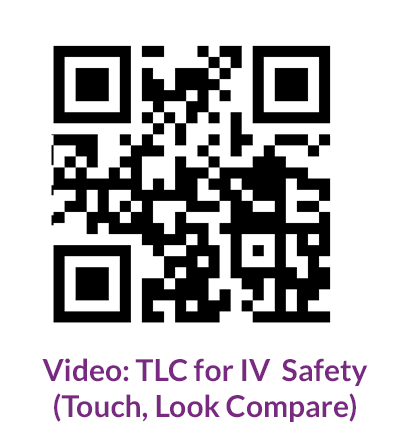
For best results make sure background graphics are enabled.
| Table of contents |
|
What is a Peripheral Intravenous (IV)? |
IV lines can be an important part of your child's care. Peripheral intravenous catheters (PIVC) are the most commonly used intravenous device in hospitalized patients. They are primarily used for therapeutic purposes such as administration of medications, fluids and/or blood products as well as blood sampling. PIVCs are associated with high rates of complications such as phlebitis, dislodgement, infiltration, occlusion, and catheter bloodstream infection.
Keeping your child safe when they require an IV line is important to your child's health-care providers. A child's safety is reinforced when parents and caregivers are informed and involved in their care.
What is an IV line
IV lines are used to deliver different types of fluids, medications, and blood products to patients of all ages. The catheter or the "line" is a thin, flexible plastic tube. A trained health care provider inserts the line into a vein in the hand, arm, foot, leg, or scalp. Fluid flows through the line directly into the child's bloodstream.
Inserting the IV line
Quick tips to improve your child's experience

An IV line has a small needle inside the tube that helps get the tube into the vein. When the nurse or doctor inserts the needle and the surrounding tube into the vein, the needle is pulled out and the plastic tube stays in place. This area of the body where the IV line is inserted is known as the "IV site." Your child may feel a small pinch when the needle is inserted, but the pain will go away once the needle is removed. The IV line is held in place at the insertion site with clear tape. You and your child may ask for pain reduction modalities with IV insertion such as topical anesthetics, 24% sucrose or child life.
Why is it important to care for an IV line?
IV lines can become dislodged or blocked and stop working, which is why it is extremely important to ensure that the IV line is protected and well-cared for. These lines allow medications, fluids, and even blood to enter the body, a necessary part of your child's medical care. Proper IV-line care reduces the risk of complications associated with IV lines.
Caring for an IV line
Intravenous lines must be properly checked and cared for to ensure the line is working properly and that there are no complications. It is the nurse's responsibility to ensure IV line safety, but parents and caregivers can assist in IV care by monitoring the line when the nurse is not present and alerting the nurse to any problems or concerns.
What your nurse will do to care for the IV line
It is the nurse's responsibility to check the IV site at least once every hour, including throughout the night. Nurses will try to minimize disruptions when checking the IV line (such as using a flashlight at night), but for safety reasons they must check the site every hours, even when your child is asleep.
Nurses will treat your child's IV line with TLC they will do the following:
-
TOUCH for signs of temperature change (heat or warmth) or leakage at the IV site.
-
LOOK to make sure the IV site is dry and visible at all times.
-
COMPARE the IV site (such as the hand or leg) with the opposite limb to look for signs of swelling.
What you can do to care for the IV line
Nurses will work with patients, parents, and caregivers to ensure the best possible care. This means encouraging patients and families to:
- notify the nurse if they notice any symptoms of complications (outlined below)
- ask questions or share concerns
- assist and support nurses caring for the IV line
Parents and caregivers can help care for the IV line when the nurse is not around by doing the following:
- Help protect the IV line. Sometimes an IV line can accidentally come out if it is bumped. Make sure the IV line does not get pulled when your child is walking, playing, using the bathroom, or getting up from a bed or chair. Ask a nurse if you need help managing the IV line during these activities.
- Speak with your child. Ask your child to tell you if the IV line hurts, or if the IV site feels tingly or numb. Remind them not to pull or tug on the IV line and to ask the nurses for help if they want to move.
- Keep IV site visible (especially when your child is sleeping). This will make it easier for the nurse to check the IV without waking your child.
- Keep the IV site dry. The IV site should be kept dry at all times. This helps prevent infection and accidental IV line removal.
- Call the nurse if you notice any signs of complications.
Complications
It’s important to know about some of the problems you may come across with your child or teen’s IV, because complications can happen at home.
Infection
With any infusion device, there is a chance of infection at the insertion site. The best way to prevent infection is to use clean technique when accessing the IV or changing the dressing. When there is a break in clean technique, or if supplies get soiled, germs can enter the body through the insertion site and cause an infection. Call your home service provider or your doctor right away if your child or teen:
- develops a fever (38.0°C) or greater by mouth (38.5°C rectal)
- has chills or sweats
- has discharge at the IV insertion site.
Not all fevers mean that there is an infection with the peripheral IV. Before you call, check to see if your child or has any other signs of infection (like a sore throat, cough or runny nose etc.). Report any changes with the periph-eral IV site.
When you come to the hospital, your child or teen may need a blood test to check for the number of blood cells that fight infection. The blood test will be taken from a vein in the arm (we can’t use the IV for this). It can take 1-3 days for the test results to come back. If the doctor thinks there is an infection from the peripheral IV site, your child or teen may need to have another IV started for intravenous antibiotics.
| What to look for | What to do |
|---|---|
| Fever, chills | Check temperature |
| Redness, swelling, discharge at the insertion site | Change dressing and check for red streak that follows the part of the catheter that is under the skin. |
| General feeling of tiredness | Look for other signs of infection |
| Fever over: 38.0°C by mouth 37.5°C under arm 38.5°C rectally | Call your Home Service Provider, your doctor or come to CHEO’s Emergency Department. |
Catheter damage
If the peripheral IV dressing is not secure over the site, the catheter can come out or become kinked. If this happens, the nurse will have to remove the IV and insert a new one.
Blood back-up in the catheter or IV tubing
This may happen if:
- your child or teen has been more active or the extension set hasn’t been clamped when not in use
- the line was not flushed well enough
- there is an opening somewhere in the system (for example, a loose connection)
If you notice blood in the catheter or IV tubing:
- Flush the catheter with saline or heparin (if ordered- follow PIV hepranization protocol)
- Check the system for leaks, cracks or loose connections.
- Replace any parts that are broken and can be replaced.
- Re-check for blood back up.
Blood clot in catheter
A blood clot may be forming in the catheter if you start to feel more pressure when flushing with sodium chloride. If this happens, notify the Home Service Provider (if applicable). The nurse may come to restart the IV or refer you to the VAT at CHEO. If needed, the nurse will call the VAT at CHEO to arrange for a visit to CHEO to have the IV replaced.
Never try to flush a clot into the body.
Air in the extension tubing
Air in the extension set tubing may mean a loose or cracked connection. Check the tubing for visible cracks and check that the connector cap is secure. It is important to find the cause of air bubbles that keep coming back. When flushing the IV, always make sure to remove all the air from the syringe first.
IV catheter falls out
Sometimes, despite your best efforts, the catheter may get pulled out by mistake. If the IV catheter comes out:
- Apply pressure for a couple of minutes to the site where the catheter enters the vein.
- Clean the site with a 70% alcohol swab and apply a bandage.
- Call the Home Service Provider (if applicable) or the VAT at CHEO about what to do next.
IV line is pulled out
If your child's IV line is accidentally pulled out, call the nurse for help. While you are waiting, apply pressure to the area (where the IV line used to be) using gauze or tissue to stop any bleeding. Hold on to the IV line until the nurse arrives.
What happens if the IV line stops working?
If the IV line is not working properly, the fluid in the IV may leak into the surrounding tissues. Your child may experience some of the symptoms described above (e.g., pain, swelling). The IV line may need to be restarted, reinserted or switched if it is not working or if it has been accidentally removed. In this situation, your child's nurse or doctor will talk to you about the next course of action.
Parents and caregivers can speak to their nurse at any time if they have questions or concerns about the IV line.
References
About Kids Health (2022). IV line care. https://www.aboutkidshealth.ca/Article?contentid=2451&language=English
1TLC+ adapted with permission from Cincinnati Children's TLC (Touch, Look, Compare) policy for peripheral intravenous catheter care.

Have you registered for MyChart?
MyChart is a FREE secure, online patient portal that connects patients to parts of their CHEO electronic health record, anywhere, at any time.
To apply for MyChart access, visit cheo.on.ca/mychart and fill out the MyChart access request form. Once your application has been approved, we'll send you an email with an activation code and instructions on how to log in and get started.





